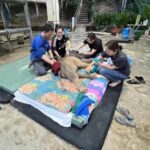SAGAING – Myanmar’s military carried out a brutal airstrike on a Buddhist festival this week, leaving at least two dozen dead and many more injured, according to a witness and the country’s civilian government in exile.
Witnesses said a motorized paraglider dropped a bomb on Monday evening at a gathering that doubled as an anti-junta protest. A second witness also confirmed that a paraglider was used in the attack.
The strike hit Chaung U township in Sagaing region, where about 100 people had gathered in a field after dark to mark a Buddhist festival of lights with a candlelit ceremony. Both witnesses spoke on condition of anonymity due to fear of reprisal.
Myanmar remains locked in a brutal civil war that has killed tens of thousands and displaced millions. There was no active fighting between military forces and resistance groups in the area on Monday.
At least 24 people were killed and at least 40 were wounded, said the first witness and Nay Phone Latt, a spokesperson for the National Unity Government, which operates in exile. Amnesty International reported a different toll, saying 18 people were killed and 45 were injured, many of them critically.
Myanmar Military Silent
A member of the Sagaing Region Strike Forces, a local resistance group, was among the dead, the group said in a statement. Myanmar’s military had not released an official response by Wednesday evening.
The junta, which has ruled for more than half a century in total, seized power again in 2021, ending a brief period of civilian rule and reigniting nationwide conflict.
Sagaing, a northwestern region near Mandalay, has seen intense fighting in recent months as the junta prepares for a December election. Independent observers say the vote will not be free or fair. Many opposition parties have been barred by the junta and intend to boycott the polls.
Joe Freeman, Amnesty International’s Myanmar researcher, said he had seen a recent rise in military strikes aimed at retaking territory. He said the junta may be trying to expand the number of areas where voting can occur to boost the appearance of credibility.
Pro-democracy groups and ethnic armed organizations control large swathes of the country, especially along the borders with China, India and Thailand. The military has clawed back some pockets, but most of Sagaing, which borders India, remains contested.
Prayers for The Dead
In the past year, the military has at times used motorized paragliders, known as paramotors, which can carry up to three people along with mortar rounds, the Office of the UN High Commissioner for Human Rights said in a recent report. Paraglider strikes have hit civilian areas in Sagaing, Rakhine and Chin states, according to the UN.
Many people in Myanmar now take cover when they hear the loud engine of a paramotor, which sounds like a chainsaw, Amnesty International reported in April. On Monday evening, those gathered in Chaung U did not hear the aircraft in time, the first witness said, as prayers were blasting from a loudspeaker.
The event marked Thadingyut, which celebrates Buddha’s return from heaven. Homes and streets across Myanmar are usually decorated with lanterns and candles as families pray in pagodas under the full moon.
People at the gathering were also protesting against the planned election, military rule and forced conscription, the first witness said.
The bomb struck at about 7 pm, hitting the centre of the crowd, according to the first witness. Children, teenagers and teachers were among the dead, both witnesses said. A second paraglider strike hit the area about four hours later and destroyed a school building. It did not directly cause further casualties, the first witness said.
Myanmar Junta Murdering of Innocent Civilians
Since the military coup in February 2021, the Myanmar military, known as the Tatmadaw, has engaged in widespread violence against civilians, resulting in thousands of deaths. Following the ousting of the democratically elected government, the military cracked down on peaceful protests, using lethal force, including live ammunition, airstrikes, and artillery bombardments, particularly in ethnic minority regions.
Reports from organizations like the United Nations and local monitoring groups document over 5,000 civilian deaths, including women, children, and activists, with many targeted during demonstrations or in deliberate attacks on villages. The military’s actions, often justified as countering resistance, have been widely condemned as war crimes, exacerbating a humanitarian crisis with mass displacement and suffering across the country.

















